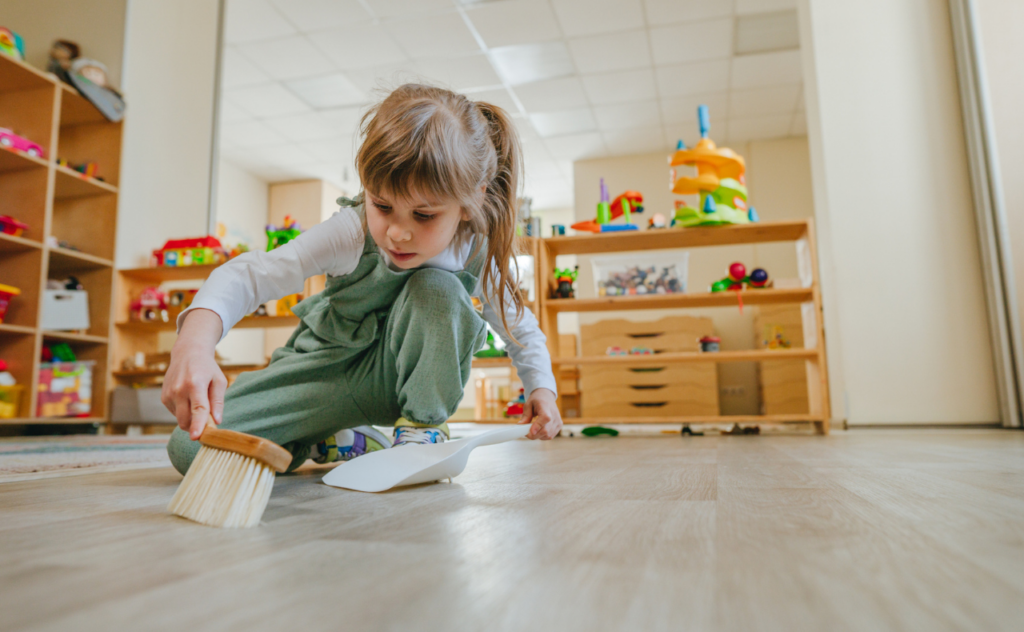Nine ways to use the Montessori method at home

How to tap into your little one’s natural curiosity
Interested in the Montessori method of learning and how you can use it at home? You’re in the right place!
Introducing Montessori learning into your child’s playroom can be easier than you might think, as it’s all about tapping into a child’s natural desire to learn.
For any child, Montessori toys can promote creative play and teach cause and effect in a way that other toys cannot. They support cognitive milestones, encourage speech development, and build fine and gross motor skills.
Lovevery Cofounder & CEO and mother of three, Jessica Rolph shares the benefits of Montessori method-inspired learning to support child development and provides tips to practice Montessori at home.
Lovevery Play Kits are backed by research and inspired by Montessori education providing play that engages a child’s natural interests, builds real-life skills, and connects your child to the world around them.
Nine simple tips to use Montessori learning at home
1. Introduce the real before the imaginary
Toddlers are curious about the world around them. Foster that curiosity by introducing them to living animals and real-world things. What can your child smell, touch, taste, hear? Multi-sensory experiences help them to make connections that will build on that curiosity and lay the foundation for more learning. Children need to experience something directly with their bodies before they can understand it in their minds.
Books about talking pigs can be whimsical and fun, but children naturally connect more with books featuring real photographs and relatable experiences, like getting hurt on the playground.

2. Encourage helping at home
Practical life is an area of Montessori that encourages young children to try real-life tasks. Invite toddlers to participate in household responsibilities (check out the Helper Kit for inspiration!). Even helping with everyday chores like laundry can make your toddler feel grown up, capable and accomplished. A child-sized squeegee or a mop make wonderful props to encourage this.
Remain open-minded about the outcomes and try to be okay with how long it takes. We want the child to develop problem solving skills, critical thinking, coordination – all of these things are more important than spilling a little juice, or unevenly chopped carrots.
3. Focus on the right challenge at the right time
Playthings in a Montessori home environment should be open-ended to spark your child’s curiosity through repetition and purpose, and by reflecting their daily experience. This style of learning and teaching is all about offering your child the kinds of challenges that develop independence and concentration.
Montessori-aligned toys help your child focus on mastering one skill at a time by minimising unnecessary distractions to deliver the right amount of challenge for your child’s exact developmental stage. Just as too many toys can be overwhelming, too many features on one toy can prevent deeper learning.

4. Practise toy rotation
Because a Montessori toy encourages concentration and has more uses than a regular toy, this means a child needs fewer toys. Less clutter not only benefits the child by allowing them to get deep into longer stretches of play, it’s also great for parents.
Rotating 4–5 toys at a time is a classic Montessori technique that lets your child take the lead through the types of play they’re naturally drawn to – creating an inviting, calming space to encourage deeper, more meaningful play.
5. Work with natural materials
Using real, natural materials like wood, cotton, felt and metal provide rich, multi-sensory experiences for your child as they explore the world around them.
Simple, natural playthings teach your baby about cause and effect: banging a wooden block on the floor makes a noise, while dropping a felt ball doesn’t.

6. Pause before stepping in
You might be surprised by how capable your toddler is if you give them an opportunity to rise to the occasion. Take a pause before stepping in to help – whether that be in pouring a drink or putting their shoes on. Because quite often those moments when your child is struggling, is when they are most likely to learn for themselves.
7. Embrace repetition
When your child works with a simple challenge over and over again, they create strong connections in their brain. As simple as they may seem, encourage those repeated efforts before adding on more difficulty. Repetition of a simple challenge, such as working with a seemingly simple task prepares their hands for more complex work later, like placing pieces into more difficult puzzles.

8. Model ‘grace and courtesy’, a Montessori practical life lesson
After you show your child how to use a toy, offer them a turn and put your hands on your lap as you observe. This lets your child take the lead in their own learning and models how to wait for a turn.
Waiting is hard for them – and sometimes for you, too; it’s natural to want to help them out. Focus on observing your child’s work and giving them a few minutes before introducing a shift in turns: “May I have a turn now?”
9. Focus on possibilities, not perfection
The toy may have a specific purpose you can present to your child, but an object’s intended purpose is just the beginning of its learning possibilities. Don’t be surprised if your child finds a completely new way to play.
What is the Montessori method?
The Montessori method of learning is child-lead and leans into our little one’s natural sense of curiosity about the world around them, and may be unique to each child.
According to Montessori Australia, this approach to education inspires children towards a lifelong love of learning, by following their natural developmental trajectory. It is “an approach to supporting the full development of the human being”. Children become confident, responsible, independent learners, who trust in their own abilities.




